wirecutter
Latest
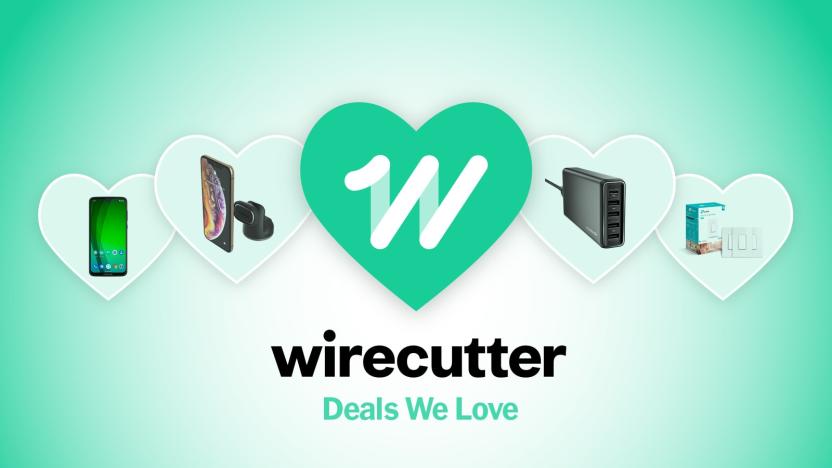
Wirecutter's best deals: Save $40 on a Motorola Moto G7 smartphone
This post was done in partnership with Wirecutter. When readers choose to buy Wirecutter's independently chosen editorial picks, it may earn affiliate commissions that support its work. Read Wirecutter's continuously updated list of deals here.
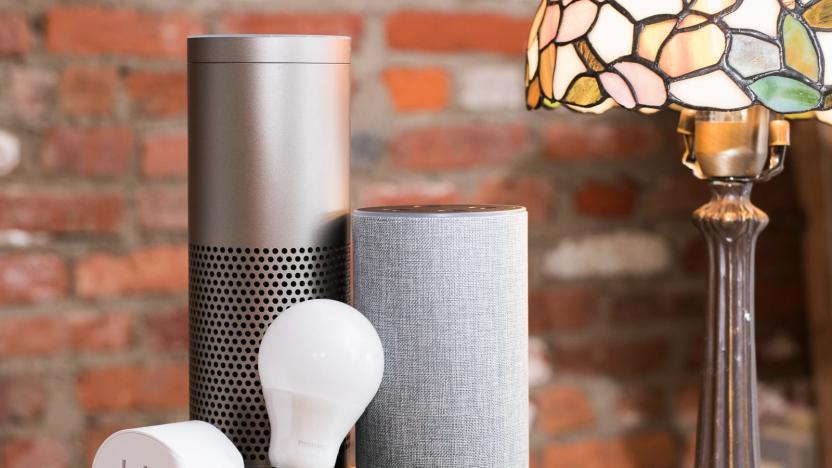
The best Alexa-compatible smart-home devices for Amazon Echo
By Rachel Cericola This post was done in partnership with Wirecutter. When readers choose to buy Wirecutter's independently chosen editorial picks, Wirecutter and Engadget may earn affiliate commission. Read the full guide to Alexa-compatible smart-home devices for Amazon Echo. Imagine walking into your home at night, arms overflowing with groceries. Even if you've installed smart lights, you'd need to put the bags down, pull out your phone, unlock it, open the app, find the control for the lights you want, and then tap the icon—might as well just stick with a plain old wired switch. But with an Alexa, you simply say, "Alexa, turn on the kitchen lights." And it's not just lights; Alexa is capable of controlling everything from basic smart plugs to garage doors. All three smart-speaker platforms (Alexa, Google Assistant, and to a lesser degree, Siri) can control a variety of smart-home devices and add an extra level of convenience to your smart-home system. We think Amazon's Alexa has a slight edge over the others because it works with more devices, and the wider family of Amazon Echo products makes it easier to fit them everyplace in your home. However, if you already have a Google Home speaker, the differences aren't large enough for you to need to switch platforms. We have guides for the best devices to use with Google Assistant and Siri/HomeKit. The Amazon Echo (or Echo Dot) offers a convenient interface for your smart home and provides functionality that an app on your phone can't. If you already have some Alexa-compatible devices or one of the three major smart-home hubs (SmartThings, Wink, or Insteon), adding an Echo can make accessing those devices more interesting and convenient. Taking advantage of its near-instantaneous response time and reliable voice-recognition processing is significantly faster than pulling out your phone and opening an app just to turn the lights on or off. Some products, such as Philips Hue lights and Nest thermostats, have native Alexa support, while others require you to enable a third-party skill. We tested plenty of both varieties to come up with the best-performing and most reliable recommendations, which we're continually testing to ensure that each new firmware and app update meets our high standards. Over the past several years, Wirecutter's editors and writers have tested just about every smart-home device of consequence. As more people end up buying smart speakers and platform support gets more and more important, we wanted to provide one place where you could access all of our picks that are compatible with the devices you already own, across all of our smart-home recommendations. Because these devices receive regular updates with additional compatibility and new features, we are continually testing and reevaluating our picks in our own homes to confirm that they still meet our recommendation standards. We'll update this guide as we learn new information, but be sure to read the full reviews if you'd like more details and test notes. If you don't yet have an Alexa-enabled device, or you want to learn more about what Alexa is and what you can do with these things, check out our full guide to Alexa and Amazon's Echo line of smart speakers.
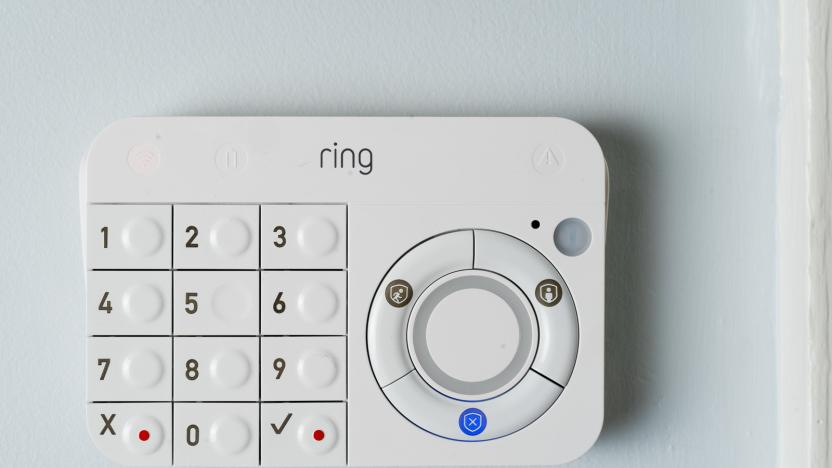
The best home security system
By Rachel Cericola This post was done in partnership with Wirecutter. When readers choose to buy Wirecutter's independently chosen editorial picks, Wirecutter and Engadget may earn affiliate commission. Read the full guide to home security systems. Peace of mind doesn't have to be pricey. Home security systems often require long contracts and pro installation, but there are smart systems you can install yourself that include a monitoring plan to keep tabs on it—and only when you want that. We found Ring Alarm to be the most affordable, comprehensive, and easy-to-use DIY home security system that has both self-monitoring and professional-monitoring options and doesn't lock you into a contract. Ring Alarm is the most comprehensive system we tested, with the most affordable monitoring plan we found. You can expand it with a variety of Ring security cameras, including indoor, outdoor, and video doorbell cameras. It also integrates with several third-party devices via the Works With Ring program, which includes brands such as First Alert, GE, Kwikset, Leviton, Schlage, Yale, and others, giving you more customization choices than other systems offer. It's also one of the few systems to provide both arming and disarming via Alexa voice commands with a four-digit PIN. Plus, you get 24/7 live customer service. SimpliSafe has a better-looking system than Ring, with voice prompts and support for Google Assistant as well as Amazon Alexa (but not Apple HomeKit). It also has add-ons such as a video camera, a doorbell camera, smoke alarms, and additional sensors. Unlike the Ring Alarm system, however, it doesn't offer outdoor cameras or self-monitoring options; you also can't add any non-SimpliSafe devices, and live customer service is available only from 9:00 a.m. to 12:00 a.m. Eastern.

Wirecutter's best deals: Save $130 on Beats Solo3 Bluetooth headphones
This post was done in partnership with Wirecutter. When readers choose to buy Wirecutter's independently chosen editorial picks, it may earn affiliate commissions that support its work. Read Wirecutter's continuously updated list of deals here.
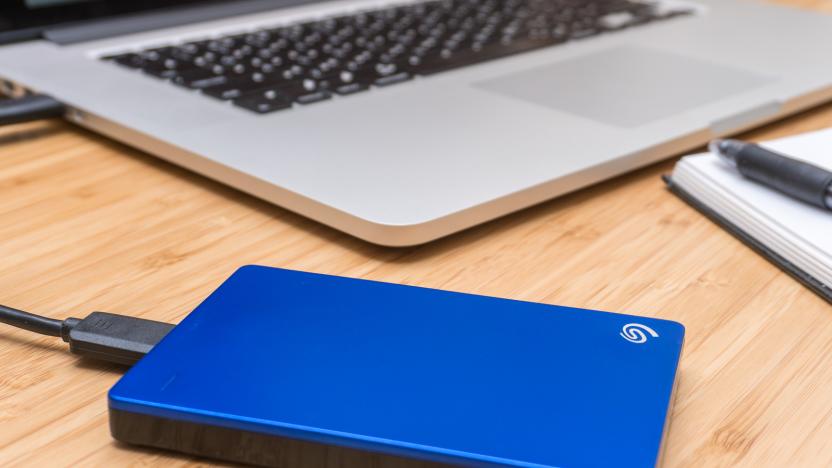
The best portable hard drive
By Justin Krajeski This post was done in partnership with Wirecutter. When readers choose to buy Wirecutter's independently chosen editorial picks, Wirecutter and Engadget may earn affiliate commission. Read the full guide to portable hard drives. After 18 hours of new research and testing, we found that the 2 TB Seagate Backup Plus Slim is still the best portable hard drive for most people. It's reliable, it's one of the lightest, thinnest hard drives we tested, and it was faster than the competition in our backup and file-transfer tests. The Slim has been one of our top picks for the past four years, and it's the only portable hard drive that we've tested that doesn't sacrifice size, speed, or reliability. Every other 2 TB portable hard drive is significantly larger, performs slower in our tests, or has a failure rate that's too high to recommend. The Slim has an acceptable 9-percent reported failure rate among nearly 2,701 user reviews. We recommend the 2 TB model because it's a great value. Seagate includes handy backup software, too. If you want more storage and don't mind a larger, heavier drive, we continue to recommend the 4 TB Seagate Backup Plus Portable, which costs less per terabyte than the 2 TB Backup Plus Slim. It was faster at sequential reading in our HD Tune test, but it was slower in our other testing. It's twice as thick as our top pick and almost twice as heavy, too. (Make sure not to buy the 4 TB Seagate Backup Plus Fast by mistake—that's a different drive that we do not recommend.)
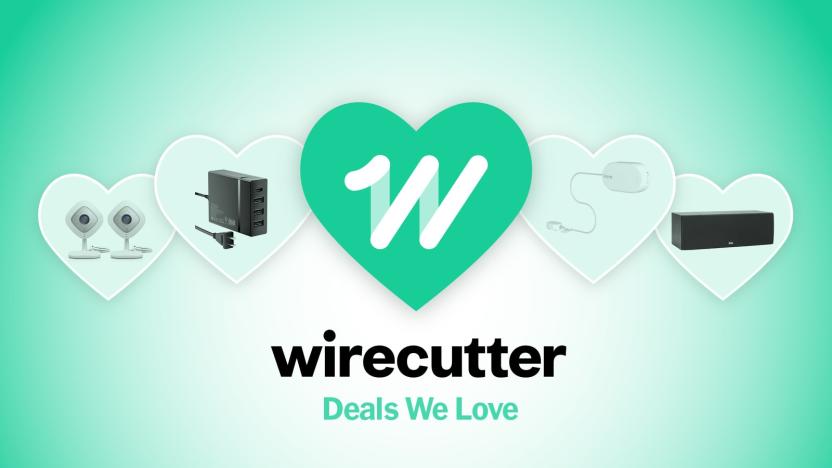
Wirecutter's best deals: Save $50 on an ELAC Debut 2.0 center speaker
This post was done in partnership with Wirecutter. When readers choose to buy Wirecutter's independently chosen editorial picks, it may earn affiliate commissions that support its work. Read Wirecutter's continuously updated list of deals here.
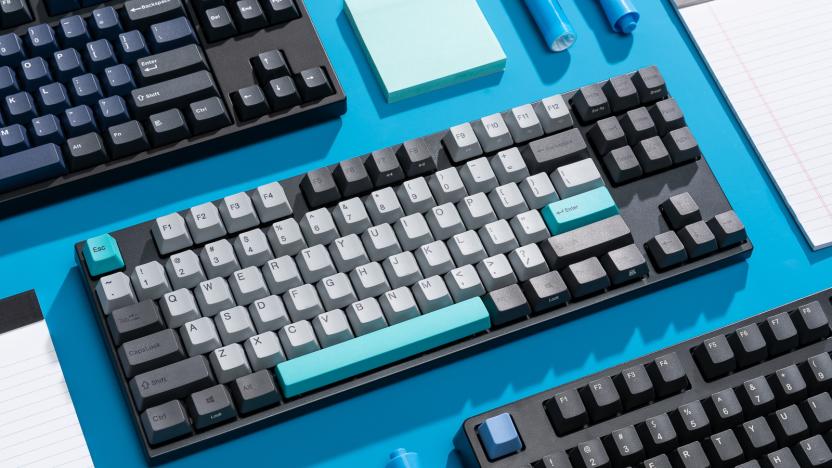
Our favorite mechanical keyboards
By Kimber Streams This post was done in partnership with Wirecutter. When readers choose to buy Wirecutter's independently chosen editorial picks, Wirecutter and Engadget may earn affiliate commission. Read the full guide to mechanical keyboards. If you spend most of your day typing or coding, a mechanical keyboard is a worthwhile upgrade over a cheaper, less comfortable keyboard. After spending months testing 19 of the most promising options, we found that the Varmilo VA87M is the best tenkeyless mechanical keyboard thanks to its excellent build quality and compact, minimalist design. It's also available with a ton of switch options and colorful high-quality keycaps to match your preference. The Varmilo VA87M is available with many different switch types, including Cherry MX Clear, MX Brown, MX Blue, MX Black, MX Red, and more. If you don't already know what switches you like, we recommend Cherry MX Brown, because they offer a satisfying tactile bump without making too much noise for a shared space. We also love that the VA87M is available with a variety of fun keycap sets and matching cases. It comes with a removable Mini-USB cable and a wire keycap puller, and it works on Windows and Mac. The VA87M isn't fully programmable, but it does have clearly labeled media keys, and you can customize a couple of functions. The VA87M typically costs around $130—about average for a great mechanical keyboard—though some switch types, keycap sets, and backlight options cost a bit extra. If the Varmilo VA87M isn't available, we recommend the Leopold FC750R. It has equally excellent build quality and a similarly compact, minimalist tenkeyless design, and it comes in all the most popular switch types. It's available with a few different tasteful, high-quality keycap sets, though it doesn't provide as much variety as the VA87M and has no backlight options. Like the Varmilo, this Leopold model has a removable Mini-USB cable and works on both Windows and Mac. But the FC750R's media keys aren't labeled on the keycaps (or explained in the manual), so you'll have to memorize them. The FC750R typically costs around $120, though some switch options cost an additional $5. Our top picks are well worth the cost because you'll use your keyboard every day for years, but if you're on a tighter budget, get the iKBC CD87. This tenkeyless keyboard offers build quality nearly as good as that of keyboards twice the price, as well as PBT keycaps and the most popular Cherry MX switch options—both rarities for a keyboard under $100. Its media keys require two hands to activate and aren't clearly labeled, its cable isn't removable, and it lacks stylish keycap options and a backlight, but the CD87 is usually around $50 cheaper than the Varmilo VA87M and Leopold FC750R. If you want a wireless mechanical keyboard, we recommend the tenkeyless iKBC CD87 BT. It's identical to our budget pick in build quality and size, it comes with the most popular switches, and it can pair with up to four devices via Bluetooth or connect via its removable USB-C cable. Unlike on the regular CD87, its volume keys are labeled and accessible with one hand, and it has DIP switches to customize the behavior of certain keys. At around $120 typically, it's reasonably priced for a Bluetooth mechanical keyboard, too. Unfortunately, availability is an issue with most great mechanical keyboards. Most are made in Taiwan or China and shipped to the United States in batches to be sold by specialty retailers such as MechanicalKeyboards.com. If our picks aren't available in the switches you want or with the keycaps you want, you can preorder at MechanicalKeyboards.com, keep an eye on that seller's incoming-shipments page, or set availability alerts on Amazon using a price tracker such as CamelCamelCamel or Keepa. We tested our picks against more readily available options and found that these models were of significantly higher quality and worth the effort to track down, but if you can't wait that long for a new keyboard, take a look at the other great options we found during testing.

Wirecutter's best deals: Save $400 on a 15-inch Apple MacBook Pro
This post was done in partnership with Wirecutter. When readers choose to buy Wirecutter's independently chosen editorial picks, it may earn affiliate commissions that support its work. Read Wirecutter's continuously updated list of deals here.
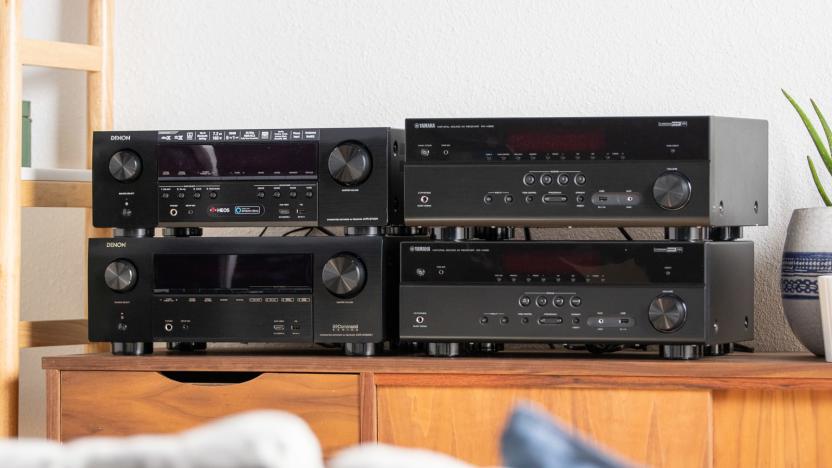
The best AV receiver
By Chris Heinonen This post was done in partnership with Wirecutter. When readers choose to buy Wirecutter's independently chosen editorial picks, Wirecutter and Engadget may earn affiliate commission. Read the full guide to AV receivers. After reviewing 16 models this year, we're confident that the Yamaha RX-V685 is the best AV receiver for people looking to build or upgrade to a home theater system compatible with the latest standards at a reasonable price. It offers excellent sound quality for surround or stereo and can support true wireless surround sound using wireless rear speakers. It includes five HDMI inputs compatible with current HDR standards plus built-in Bluetooth, AirPlay, and support for the major music streaming services. The Yamaha RX-V685 home theater receiver offers excellent sound quality, producing a wider soundstage and better midrange/treble detail than most of the competition. And if you can't run wires around your room, it can output true wireless surround sound using Yamaha MusicCast rear speakers. This 7.2-channel receiver also supports Dolby Atmos and DTS:X soundtracks if you want to add the extra channels, or it can create a powered second zone for stereo speakers instead. Its five HDMI 2.0 inputs are enough for most systems, and its dual HDMI outputs are ideal if you use both a TV and projector. Yamaha's built-in room correction feature effectively measures your speakers and makes adjustments automatically, and there's an optional app for easier setup. The RX-V685 supports Spotify Connect, Internet radio, Bluetooth, AirPlay, and other streaming services. A firmware update later this year will provide support for eARC and AirPlay 2. The Denon AVR-S740H doesn't sound quite as good as the Yamaha RX-V685, but its on-screen setup is the best we've seen, which makes it a great choice for someone who is new to the home theater setup process. Like our top pick, this 7.2-channel receiver offers solid room correction, Dolby Atmos/DTS:X decoding, HDR passthrough, good streaming music support, and five rear-panel HDMI 2.0 inputs (and it adds a front-panel HDMI input). If you're looking for a basic five-channel home theater receiver, the Yamaha RX-V485 offers more features than you'll find on most budget AV receivers for only a small step up in price. It offers many of the features of our main pick, including the option to use wireless surround speakers and built-in Wi-Fi to stream audio directly from Spotify and other online sources. But the RX-V485 has fewer HDMI inputs, its room correction isn't as good as the version on our main pick, it doesn't have a phono input, and it doesn't support Dolby Atmos or a second powered audio zone. If you have a large system that needs more than five HDMI inputs and/or you want to run multiple subwoofers that need to be individually calibrated in the room correction system, the Denon AVR-X3500H has you covered. It uses Audyssey XT32, the most advanced room correction system we tested this year (and the system with the best overall audio quality). With more HDMI inputs, this receiver can accommodate larger systems, and it has pre-outs if you want to add external amplification (and thus more speakers) down the road.
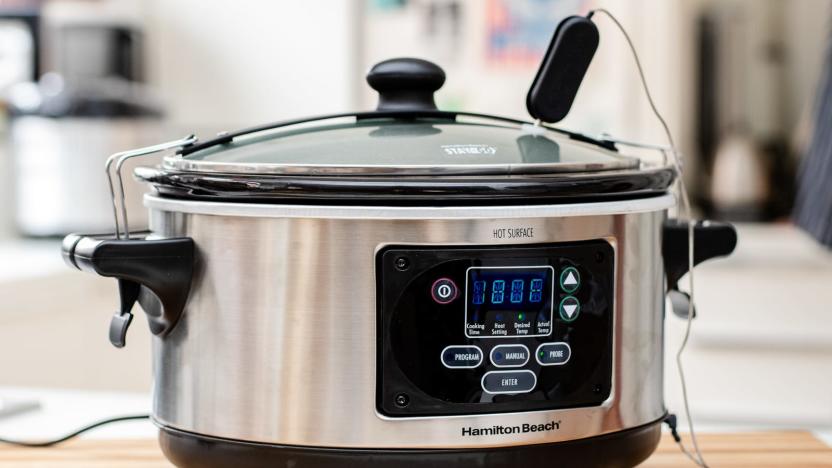
The best slow cooker
By Anna Perling, Christine Cyr Clisset, Camille Chatterjee and Lesley Stockton This post was done in partnership with Wirecutter. When readers choose to buy Wirecutter's independently chosen editorial picks, Wirecutter and Engadget may earn affiliate commission. Read the full guide to slow cookers. We've been recommending the Hamilton Beach Set & Forget 6 Quart Programmable Slow Cooker since we first published this review in 2013. And after testing it against eight new competitors, we've found that it still offers the best performance and features of any available slow cooker. The Set & Forget consistently cooked foods at a gentle simmer, making the most tender roast in our tests. It's one of the few cookers we tested with a locking lid that seals tightly for easy transport, as well as a probe thermometer so you can cook to a target temperature. The Hamilton Beach Set & Forget 6 Quart Programmable Slow Cooker has been our top pick since 2013. A common complaint among owners of slow cookers is that they cook foods too hot, but in our tests the Set & Forget successfully simmered beans on a low setting without boiling them and turning them to mush. And even on a high setting, it was able to cook at moderate enough temperatures to produce a fall-apart tender roast. Its intuitive interface, probe thermometer, locking lid, and modest price make it the best cooker of the models we tested. If you want a longer timer or a more precise probe thermometer, we recommend the Hamilton Beach Temp Tracker 6 Quart Slow Cooker. The Temp Tracker is similar to our top pick but has a 24-hour timer, more built-in slots for a probe thermometer, and a medium setting as well as high, low, and warm. Unlike with the Set & Forget, the probe thermometer reads to the degree, and you can set it to a wider range of target cooking temperatures. But this model ran a little hotter in our tests, and we're not convinced that everyone needs the extras, which go above and beyond the "set it and forget it" slow cooker mantra.

The best robotics kits for beginners
By Signe Brewster This post was done in partnership with Wirecutter. When readers choose to buy Wirecutter's independently chosen editorial picks, Wirecutter and Engadget may earn affiliate commission. Read the full guide to robotics kits for beginners. When we tested robotics kits for beginners, the Lego Boost set won over the toughest critics: kids. And robotics pros, makers, and hobbyists agreed. With its Lego-based design, built-in sensors, and expansive options for creativity, the Boost kit was the most fun to build with. Plus, the tablet app's super-simple programming was the easiest to learn of any of the kits we tried. Since it uses Lego pieces, the Lego Boost set is the most approachable and the easiest to figure out how to put together. It's a well-thought-out kit that a panel of child testers enjoyed as much as we did. The simple programming interface is easy to get started with, and the visual instructions allow non-readers to use and enjoy it, though more advanced programmers might find it limiting. If our main pick is unavailable, the next-best option is the Ubtech Jimu Robot AstroBot Series: Cosmos Kit. The companion smartphone and tablet app that leads you through building and programming is the most organized and simple to learn of any we tried. The clear instructions offer a straightforward introduction to the popular Scratch programming language. The blocklike Jimu building pieces aren't as versatile as Legos, and they feel a little clunky, but they come together to build a capable robot. If you're hungry to do as much as you can with a robotics kit, the Vex IQ Super Kit will satiate your appetite for new skills whereas simpler and less expensive kits may only be an appetizer. You can begin programming this kit with a graphical language or move up to more complex tasks using the C programming language, and the extra sensors—which can detect colors, for instance, or when the robot bumps into something—add possibilities that simple kits lack. The kit is made for educators, and as a result it has some of the most solid pieces and packaging.
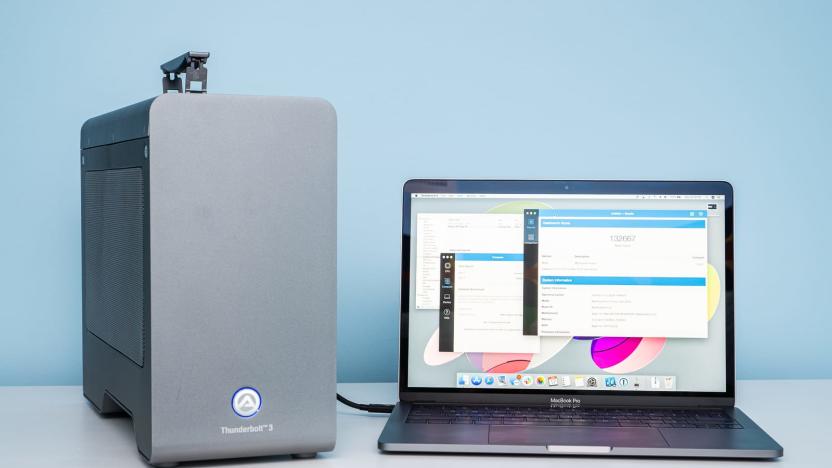
The best external graphics card enclosure
By Andrew Cunningham This post was done in partnership with Wirecutter. When readers choose to buy Wirecutter's independently chosen editorial picks, Wirecutter and Engadget may earn affiliate commission. Read the full guide to external graphics card enclosures. For laptops or mini PCs with Thunderbolt 3 ports, adding an external graphics card (or eGPU) can be a good way to play high-end games, run professional 3D apps, and connect as many as half a dozen monitors. After researching nearly 30 Thunderbolt 3 eGPU enclosures and testing six, we think Akitio's Node Pro is the best box you can buy to put your graphics card in. The Akitio Node Pro is a bit slimmer than other eGPU enclosures and has an understated, all-metal design that looks better than most of the plain black boxes in this category (it looks especially at home next to Macs). You can open it and install or swap out graphics cards without any tools at all—on most enclosures you need at least a screwdriver to access the interior—its fan is relatively quiet, and it has a second Thunderbolt 3 port that you can use to connect other accessories. It can provide up to 60 W of power to a connected laptop, more than enough to keep most 13-inch notebooks charged while you use them. And it has a neat retractable handle you can use to carry it from place to place. The Razer Core X Chroma is bigger, boxier, and more expensive than the Node Pro, but it also includes a Gigabit Ethernet port, four USB 3.1 Gen 1 Type-A ports for connecting accessories, and customizable RGB lights that can add a flashy, colorful touch to your gaming setup. It can also provide up to 100 W of power to a connected laptop, enough for some 15-inch laptops like Apple's 15-inch MacBook Pro (though others exceed USB-C's 100 W charging limit). If you're looking for a Thunderbolt 3 graphics card enclosure that can double as a laptop dock, this is the one to get. The 550 W version of Sonnet's eGFX Breakaway Box (which also comes in a 650 W version) typically costs between $100 and $150 less than our other picks, money that you could put toward a more powerful graphics card. But its design is more utilitarian than that of our other picks, it's not as easy to open, and its fan is a bit noisier. These shortcomings are forgivable for the price, but most people will be better served by the Akitio Node Pro.
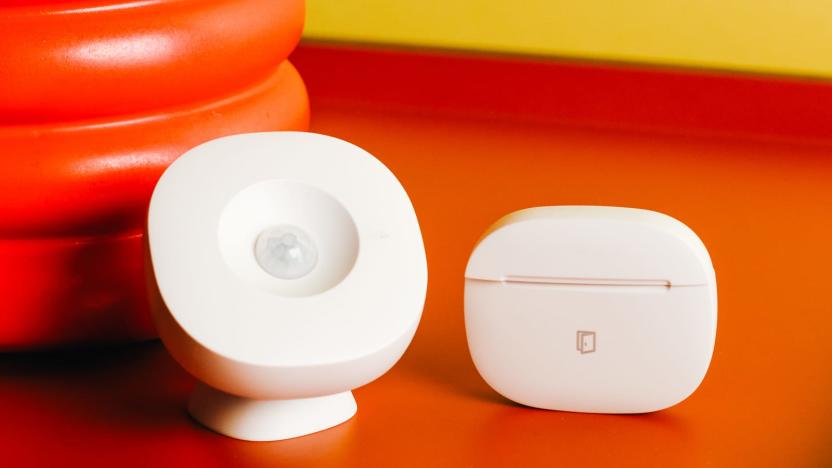
The best smart home sensors for Alexa
By Jennifer Pattison Tuohy This post was done in partnership with Wirecutter. When readers choose to buy Wirecutter's independently chosen editorial picks, Wirecutter and Engadget may earn affiliate commission. Read the full guide to smart home sensors for Alexa. Among Alexa's many tricks is that it also works as a smart-home hub. And adding smart sensors to an Echo Show or Echo Plus can turn either device into more than just an opponent for 20 Questions. Different sensors detect activity such as motion, a door or window opening, and temperature, and then tell other devices how to react. We recommend the Samsung SmartThings Motion Sensor and Samsung SmartThings Multipurpose Sensor for their reliability and wide compatibility with other devices. The Samsung SmartThings Motion Sensor stands out among the few Alexa-compatible sensors because its long range lets it easily cover a large room (or even two), it can trigger in reaction to temperature as well as motion, and it's super easy to pair with an Echo Plus or Echo Show (no SmartThings hub needed), so you can run Alexa Routines based on motion or temperature changes in the room. It's a breeze to install, and thanks to a magnetic mount that's easy to adjust, it fits almost anywhere you need it. The sensor is also water resistant (although it's recommended only for indoor use). At a typical price of just $20, the tiny Samsung SmartThings Multipurpose Sensor (Zigbee) does a lot for very little. Its main purpose is to serve as a contact sensor, and you can easily stick one of these on any door, window, or drawer to detect when they open or close. But it also has temperature and vibration sensors inside, so it can alert you—or act as a trigger for other smart devices—if a room or area is too hot or too cold. That makes it the most versatile sensor we tested: You can just as easily keep tabs on the doors and windows of a rental property as on a precious liquor cabinet.
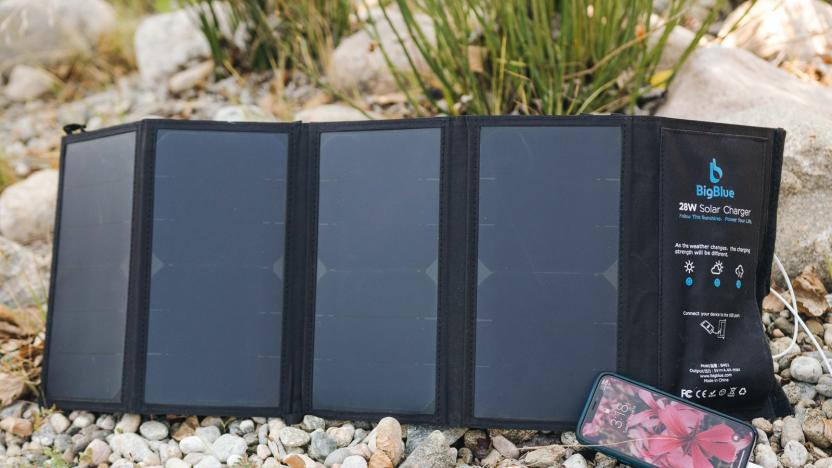
The best portable solar battery charger
By Sarah Witman This post was done in partnership with Wirecutter. When readers choose to buy Wirecutter's independently chosen editorial picks, Wirecutter and Engadget may earn affiliate commission. Read the full guide to portable solar battery chargers. Unlike the finite energy stored in a battery pack, a USB solar charger offers a tiny power plant that can generate power for your phone and small electronics to keep them charged when the sun is out—you can even use one to recharge a power bank and save that energy for later. After spending more than 60 hours testing 12 models, we're confident that the BigBlue 28W USB Solar Charger is the best portable solar charger for people who need to charge their gadgets and stay connected in an emergency or when they're off the grid. The BigBlue 28W USB Solar Charger produces the most power of any portable solar charger we've tested, and it has unique features that make it more versatile and durable, including three output ports (versus two on most other chargers), a weatherproof port protector, and an expansive but lightweight array of panels to catch every last ray of sunlight. Although other models come close to matching it in terms of power, the BigBlue is also smaller and lighter than other options with similar output, so it can more easily fit into a camping backpack, hiking daypack, or emergency kit. If the BigBlue is unavailable, we also like the X-Dragon 20W SunPower Solar Charger. In testing, it was second only to our top pick in terms of how much power it produced throughout the day, and it even produced a little more when the sun was at its peak midday. While this model will charge up your devices just as fast as our top pick, the X-Dragon lacks the convenient extras—such as the additional charging port and the port protector—that make the BigBlue stand out.
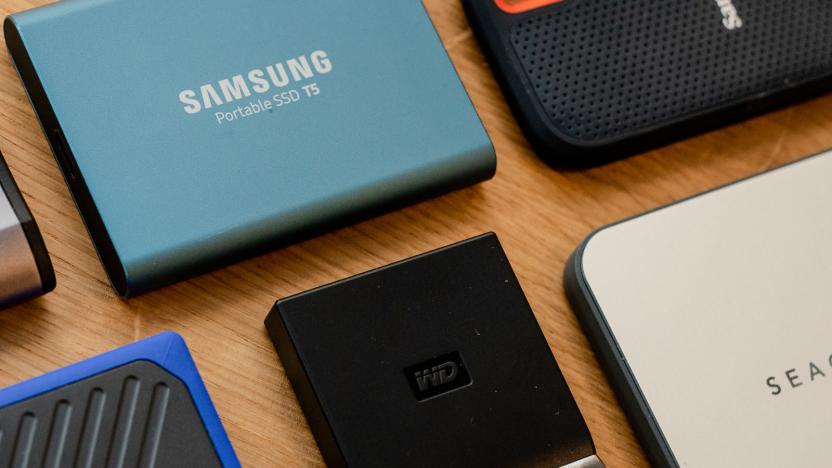
The best portable SSD
By Justin Krajeski This post was done in partnership with Wirecutter. When readers choose to buy Wirecutter's independently chosen editorial picks, Wirecutter and Engadget may earn affiliate commission. Read the full guide to portable SSDs. If you frequently move large files between computers and want a fast, small device to do it with, you should get a portable SSD. After researching 17 portable SSDs and testing the five most promising in 2019, we found that the 500 GB Samsung T5 was the best. It's fast, compact, competitively priced, and reliable, and the one we tested has worked well for the past two years. The 500 GB Samsung T5 Portable SSD is about as expensive per gigabyte as other external SSDs. It's also very light and compact, so you can easily throw it in your bag (or even tuck it inside your pocket) when you're on the go. The T5 has one USB 3.1 Gen 2 Type-C port that supports USB transfer speeds of up to 10 Gbps, and unlike other portable SSDs we tested, it includes cables to connect to both new and old devices, as well as useful AES 256-bit hardware encryption to protect your sensitive data. The T5 had software that was pleasant to navigate, with a clean layout; other portable SSDs we tested didn't include software, or their software was bloated and less intuitive. With the T5, it's a breeze to set up encryption or check for updates. Plus it has an indicator that lights up when it's connected and blinks while it's actively transferring (a minor perk, but one that makes life easier), and it comes with a three-year warranty. If you want more storage and you're willing to pay for it, we recommend the 1 TB Samsung T5 Portable SSD. Since higher-capacity solid-state drives often provide slightly improved performance, we expect the 1 TB version to be a little faster than the 500 GB model, although we weren't able to test it. It's otherwise identical to the 500 GB model in size and features, and it costs about the same per gigabyte as the 500 GB version. If the Samsung T5 is sold out or unavailable, or if the T5 is significantly more expensive, we recommend the 512 GB Western Digital My Passport SSD. Like the T5, the My Passport SSD supports USB 3.1 Gen 2 transfer speeds, and in our testing it was about 10 MB/s slower than the Samsung T5, a borderline imperceptible difference. The My Passport SSD is longer, thinner, and a bit lighter than the Samsung, but they're both pretty darn compact—and they're smaller than everything else we tested that performed comparably. It has one USB-C port and comes with a USB-C–to–USB-C cable, as well as a tiny USB-C–to–USB-A adapter, which seems easy to lose compared with the USB-C–to–USB-A cable that comes with the Samsung T5. Like the Samsung—and unlike its competition—the My Passport SSD has AES 256-bit hardware encryption to reliably protect your sensitive information. And it comes with a solid, three-year warranty. But some Amazon reviewers found its software annoying, and it lacks the Samsung's helpful activity indicator light.
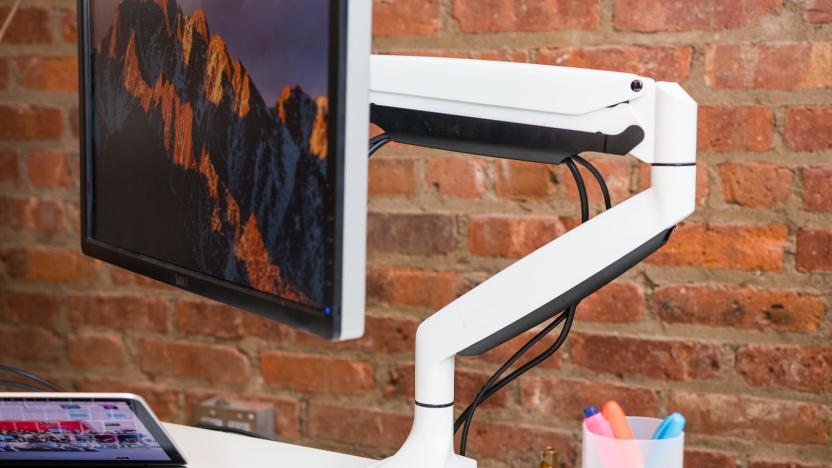
The best monitor arms
By Anna Perling and Jordan McMahon This post was done in partnership with Wirecutter. When readers choose to buy Wirecutter's independently chosen editorial picks, Wirecutter and Engadget may earn affiliate commission. Read the full guide to monitor arms. A great monitor arm can save space on your desk and make your workspace more comfortable and ergonomic. After researching more than 60 monitor arms and testing 13 over the past two years, we found that the Fully Jarvis Monitor Arm is the best option. It's easy to set up, it moves smoothly into a wide range of positions and angles, and it has a solid five-year warranty. The Fully Jarvis Monitor Arm has the same wide range of motion and sturdy build quality as its closest competitors but adds a sleeker design, three color options, and a five-year warranty without a huge price leap. Since it can support monitors up to 32 inches and about 20 pounds, it should work not just with the display you have now but with a potential upgrade in the future as well. If you're considering our runner-up standing desk, Fully gives you a discount on the monitor arm when you buy them together. Supported monitor size: 13 to 32 inches Supported monitor weight: 2.2 to 19.8 pounds Maximum height: 19.8 inches from tabletop If the Fully Jarvis sells out and you can't wait for it to restock, the Ergotron LX Desk Monitor Arm will work just as well. The LX has nearly identical vertical and side-to-side ranges, tilt, and pan and rotation capabilities. Ergotron monitor arms generally cost more than similar options not because of any additional features but because of the company's impressively long, 10-year warranty. Though 10 years may seem like overkill, we think paying for such coverage is a better option than going for the savings provided by other models that offer only a one-year warranty—a monitor arm should last you many years, and the company that makes it should stand behind it. Supported monitor size: up to 34 inches Supported monitor weight: 7 to 25 pounds Maximum height: 25 inches from tabletop People over 6 feet tall need added vertical range to position a monitor at the right height, especially with a desk that lets you switch positions from sitting to standing. The Ergotron LX Desk Monitor Arm, Tall Pole has a 13¼-inch pole and can hold a monitor nearly 15 inches higher than the maximum height of the Fully Jarvis. In our tests we found that the extra height provided an ergonomically ideal range for tall people. In other respects, the Ergotron LX Tall Pole is identical to the standard Ergotron LX arm; it's just as sturdy and easy to assemble. Supported monitor size: up to 34 inches Supported monitor weight: 7 to 25 pounds Maximum height: 34 inches from tabletop If you're looking for a dual-monitor arm, we like the Fully Jarvis Dual Monitor Arm. As with the single-arm versions, the Jarvis dual model costs substantially less than its Ergotron counterpart—in this case, just over half as much—but comes with a shorter warranty. At five years, the Jarvis's warranty is still plenty of coverage, and the simple setup and attractive design make the Jarvis the best dual-monitor arm for most people. Supported monitor size: 13 to 32 inches Supported monitor weight: 2.2 to 19.8 pounds Maximum height: 19.8 inches from tabletop

The best ice cream maker
By Marguerite Preston and Lesley Stockton This post was done in partnership with Wirecutter. When readers choose to buy Wirecutter's independently chosen editorial picks, Wirecutter and Engadget may earn affiliate commission. Read the full guide to ice cream makers. After researching for 95 hours, testing 16 machines, talking with pro ice cream makers and a food scientist, and churning gallons of the frozen stuff since 2014, we think the Whynter ICM-15LS is your best bet for making consistently great ice cream at home. It's not cheap, but because it's so easy to use and it essentially guarantees success, it would likely get a lot more play in your kitchen than cheaper, more finicky machines. The Whynter ICM-15LS not only made some of the smoothest ice cream in our testing but also ranked as the quietest-running maker we tried and the easiest to scoop from and clean. And since it's a self-refrigerating compressor machine, you won't have to deal with freezing an insert bowl or futzing with messy ice and salt. If the Whynter ICM-15LS sells out, or you just want more bells and whistles, the Breville Smart Scoop is a great alternative. Although it made slightly creamier ice cream than our top pick, the difference was so subtle that we don't think it's worth the extra $100 or more for most people. It has an auto function with 12 hardness settings and a keep-cool function so you can set your ice cream and walk away. And its brightly lit LCD screen and control panel with big buttons make it easy to use—even for kids. The Lello 4080 Musso Lussino is the crème de la crème of home ice cream makers. In our tests the large, sleek machine churned out smooth and creamy batches of ice cream in less than 30 minutes, the fastest of any model we tried. And our tasters unanimously voted its ice cream the smoothest and best-flavored. But its jaw-dropping price makes the Musso Lussino too expensive for casual dessert-making. If you plan on making more than a quart of ice cream a week, this might be the machine for you. If a $200 price tag on an ice cream maker sounds steep to you, consider the affordable Nostalgia ICMP400, which is just one step beyond old-fashioned hand-crank models. While it still requires you to add ice and salt to freeze the mixture, this machine is fitted with a motor to do all of the hard work for you. In our tests its ice cream was slightly icier than that from our main pick but still tasty. It makes up to 1 gallon at a time, and as long as you have enough ice and rock salt, you can turn ice cream all day. If you own a KitchenAid stand mixer, we really like the KitchenAid Ice Cream Maker KICA0WH attachment, as well. This is a bowl that requires prefreezing, which necessitates more planning ahead than our main pick. In our tests it made the absolute fluffiest ice cream of the machines we tried, since the lowest setting on the KitchenAid stand mixer is still faster than the speed at which ice cream makers spin. We didn't mind the texture at all; in fact, it was quite pleasant.

The best electric razor
By Dan Koeppel This post was done in partnership with Wirecutter. When readers choose to buy Wirecutter's independently chosen editorial picks, Wirecutter and Engadget may earn affiliate commission. Read the full guide to electric razors.

The best budget subwoofer
By Brent Butterworth This post was done in partnership with Wirecutter. When readers choose to buy Wirecutter's independently chosen editorial picks, Wirecutter and Engadget may earn affiliate commission. Read the full guide to budget subwoofers. Adding extra bass with a subwoofer is the surest way to make a sound system more satisfying. Our new pick for the best budget subwoofer is the Dayton Audio SUB-1200. It kicks out enough deep bass to shake your couch, it's easy to hook up, and it's a little more attractive (or a little less unattractive, depending on your perspective) than most budget subs. The Dayton Audio SUB-1200 12-inch subwoofer is a step up from the other budget subs we tested in a few ways. It has a more powerful bass than similarly sized models we tried, which means it can deliver a little more of that satisfying couch-shaking that makes action movies more realistic. Its rounded corners and flush-fit round grille make it more attractive than most budget subs, and its large rear panel and multiple connection options make it easy to connect to any system. The Dayton Audio SUB-1000L 10-inch subwoofer is built for people who want more bass in their audio system but don't have space for a conventional subwoofer. At only 6 inches thick, it's slim enough to slip behind many couches and chairs and even under some couches. You can also attach it to a wall using the included mounting system. Its output doesn't match that of the Dayton SUB-1200, but it has enough power to work well in a modest home-theater system or in a stereo system with bookshelf speakers.
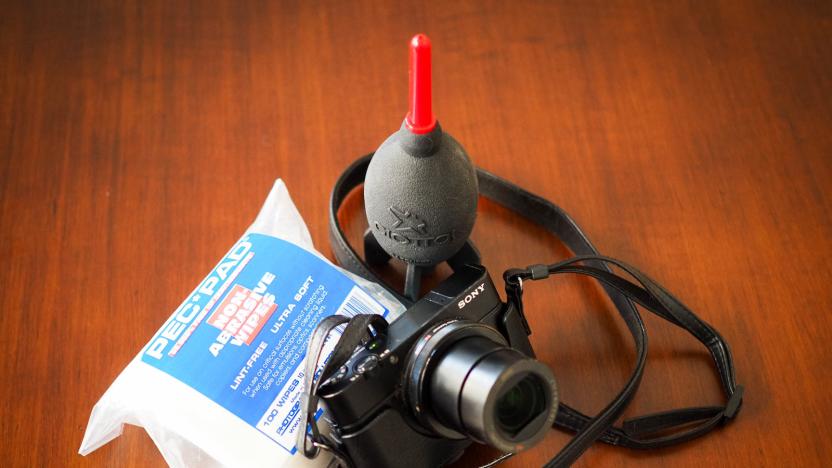
The best camera cleaning gear
By Tim Barribeau and Ben Keough This post was done in partnership with Wirecutter. When readers choose to buy Wirecutter's independently chosen editorial picks, Wirecutter and Engadget may earn affiliate commission. Read the full guide to camera cleaning gear. A camera, a lens, a memory card, and a decent eye are all you need to take a good photo. But you need some other things if you want to keep your camera and lenses in good shape, since photography isn't a sterile business. Unless you're shooting in a studio at all times, dust, mist, mud, rain, sea spray, and other outdoor filth can easily dirty your camera. And that can affect the quality of your photos. For cleaning the front element of your lens, we recommend the Giottos Rocket Air Blaster, a LensPen, a set of PEC-PAD wipes, and a vial of Eclipse cleaner. With these items in your bag, you should be prepared for anything the world can throw at your camera.